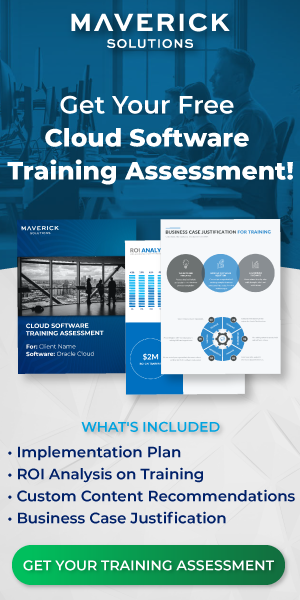Author: Sam Griffin
Recruiting candidates to fill new and newly available positions at your business is a daunting task no matter the size of your human resources (HR) department. Even with a full HR team, fielding and evaluating hundreds of candidates for a handful of openings is daunting. This is doubly true if you are the lone HR team member trying to find the right candidates to schedule for interviews.
Read on to learn how to automate the candidate selection process in Oracle Recruiting Cloud.
How can Oracle improve my hiring process?
The various processes related to hiring are made easier using the tools found in Oracle Recruiting Cloud, provided you know how to make this section of Oracle Human Capital Management (HCM) Cloud work for you.
Oracle Recruiting Cloud assists organizations with creating job requisitions, processing job applications, and creating customized questionnaires and other notifications to send to prospective candidates. This is a long and sometimes complicated process, but many of the tasks related to these processes can be automated after being properly configured to meet the needs of your business.
How do I create a job requisition using Oracle Recruiting Cloud and who is involved?
Users can involve Oracle in multiple aspects of the hiring process, which logically starts when your HR team creates and shares a new job requisition. Oracle requires this process to be carried out by a hiring manager, a recruiter, or both roles working together.
When working alone, either a hiring manager or recruiter begins by initiating the job requisition process using the Create Job Requisition action found in the Quick Actions page in the Hiring work area. Job requisitions travel through phases and states representing their progress during the creation process, and a new job requisition begins in the Draft phase and the In Progress state.
Once the job requisition is initiated, the hiring manager or recruiter performs the following actions:
- Add job requisition details.
- Submit the requisition for approval.
- Add job formatting details (includes additional media such as videos).
- Post the job requisition to relevant job boards and career sites.
When a hiring manager and recruiter work together to create a job requisition, the hiring manager handles initiating the process and then a notification is sent to the recruiter requesting their assistance. The recruiter then handles the remaining tasks like populating the job requisition with details, submitting the requisition for approval, adding job formatting details, and posting the job requisition.
This process can be improved by adding collaborators. By default, collaborators receive viewing access for the requisition being worked on so that they can assist, review details, and provide input in the process. This is useful because this process takes time and there can be a lot of different details to include like a description of the job and the job’s primary work location.
Fortunately, this is a process that should only need to be performed from the ground up once. That is to say, once your team has created one job requisition successfully, they can use it as a template of sorts for future job requisitions and start simplifying the hiring process.
How do job requisition creation methods speed up hiring?
A job requisition is required to hire and process a candidate in Oracle, and job requisition creation methods determine how a job requisition is built. We’ve already discussed the first method, which is to take a blank requisition without any pre-populated values and fill it out with relevant details and configurable settings. Now, we can move past this build-it-from-scratch technique and try one of the following other methods out:
- Existing requisition: You can create a new job requisition based off a duplicate of a preexisting job requisition. If you’ve done the job once already, why not reuse some of your work?
- Template: You are able to create job requisition templates that act as a partially created job requisition with some customization required.
- Job: You can create a job requisition using an existing job as the basis. A job in Oracle refers to generic role within an established business group like Manager or Consultant.
- Position: You can create a job requisition using an existing or new position as the basis. A position in Oracle refers to a specific instance of one job specific to your organization. For example, a food service business might need to fill a Cafeteria Manager position specific to one of their locations.
Each of these methods speed up the job requisition creation process by populating certain fields.
For example, the existing requisition method will pre-populate all field values from the requisition it is copying except the Requisition Number- this is the unique string of characters representing a requisition. Also, the method for creating a job requisition based on a new position can be configured to skip the approval step, speeding up the process further. This method’s requisition details are enabled within the position creation flow using the Transaction Design Studio, a feature available within the HCM Experience Design Studio.
What is Oracle’s candidate selection process?
The candidate selection process refers to a candidate’s journey from an applicant to a new hire ready to work. Once work is complete on a new job requisition, your team can begin fielding applicants for hiring. Like with creating new job requisitions, this process is fairly involved but can be made simpler over time.
This process starts when you receive the first application from a candidate who has found your posted job requisition. The system tracks the candidates’ progression as their application moves through phases and states within those phases. The five default phases for the candidate selection process and examples of their corresponding states are as follows:
- New: This is the earliest stage for candidates when the hiring team is first reviewing applications for a requisition, and it includes states like To Be Reviewed, Reviewed, and Selected for Screening.
- Screening: This is the phase where a hiring team member first contacts a candidate and decides whether to invite that candidate to a formal interview. It includes states like Selected for Interview, Phone Screening Completed, and Phone Screen to Be Scheduled.
- Interview and Selection: This is the phase where the interview team formally interviews several candidates for a position and provides feedback on each candidate’s suitability for the position; this phase ends with the candidate/s being selected to fill the requisition. It includes states like Interview Completed, Feedback Requested, and Selected for Offer.
- Offer: This is the first of two mandatory phases for each candidate selection process; this phase starts with the drafting of the offer and concludes when the candidate accepts the offer. It includes states like Draft, Pending Approval, Approved, Extended, and Accepted.
- HR: This is the secondary mandatory phase in each candidate selection phase; this phase involves the steps the human resources (HR) department will take until the candidate becomes an employee. It includes states like To Be Processed, Processing, and Processed.
Your hiring team can add additional components to the basic five stage process to fit your company’s needs such as providing a list of reasons for rejecting a candidate or establishing automatic notifications to inform candidates of their application’s progress.
How can I automate the candidate selection process in Oracle Recruiting Cloud?
The candidate selection process is designed with opportunities to automate in mind. At its most basic, configuration team members can automate an application’s transition from phase to phase and state to state so that your hiring manager or recruiter doesn’t have to keep manually moving an application with the Move action.
These movements are based on conditions your team establishes. Conditions trigger the Move action and can be events like receiving interview feedback or completing and submitting a candidate assessment. However, be aware that the following scenarios can block an automatic Move action from being carried out:
- If the job application is in the Rejected by Employer or Withdrawn by Candidate state in any phase, it will not automatically move.
- If the job application in the Offer phase is in any state other than Offer – Accepted or an event is occurring in the Offer phase, it will not automatically move.
- If the job application has entered any state in the HR phase, it will not automatically move. This is because this is the last phase before the applicant becomes a new hire and is processed as such.
Oracle provides the following predefined conditions you can use in the candidate selection process immediately:
- Your company receives interview feedback.
- There is an error present in an assessment.
- The candidate completes a series of assessments and fails some.
- The candidate completes and passes every assessment in a series.
- There is an error present in a candidate’s background check.
- The candidate’s background check is complete.
- The job application is external.
- The job application is internal.
Conditions are created using fast formulas. These formulas include a conditional variable and a conditional message for information logging purposes. Conditions can be established by configuration team members using the Fast Formulas task located in Setup and Maintenance and by choosing the Recruiting Candidate Selection Process as the Type field for the formula.
Other opportunities for automation
You now know the basics of processing applicants more efficiently through automation, but this is just the beginning. Many other aspects of the job requisition creation process, the candidate selection process, and new hire processing. Whether its taking down job requisitions from career boards after a certain number of applicants apply or disqualifying candidates based on questionnaire responses, many duties can be automated to provide your HR team with the support it needs to find the right candidates.
If you would like to learn more about automation opportunities in Oracle Recruiting Cloud or gain a better understanding of Oracle HCM Cloud as a whole, consider ENGAGE by Maverick.
ENGAGE is Maverick Solutions’ comprehensive, subscription-based training model for Oracle Cloud applications. ENGAGE is both a learning platform and a GPS for your Oracle Cloud software.
Our learning platform contains thousands of training resources and interactive training simulations that walk users step-by-step through complex business processes. The GPS is accessible in the live Oracle application and guides users in real time with any issues in the system.
Let us know how Maverick Solutions can help you get your teams trained on Oracle Cloud. Call (919) 844-2000 to speak with one of our customer service representatives today to learn more or request a demo.
The article was written for Oracle release 21C. Due to the nature of Cloud software and updates, this article may no longer be accurate. If you would like access to the most up-to-date version, please reach out to our team to learn more.





